
SomeaKenya provides Updated and Revised notes for the current CPA syllabus. Revision kits (Past papers with answers) are also available to help you with revision of the upcoming exams. You can get these materials in Hardcopies (Printed and Binded) and also available in Softcopy form when you subscribe on mobile or Desktop/Laptop someakenya Application. (Note: Softcopies are not Printable and can only be read using android phones) Click here to download SOMEAKENYA APP from Google Playstore.
Full Access to these notes/Kit on Desktop/Laptop via https://desktop.someakenya.co.ke
Or through Our Mobile App
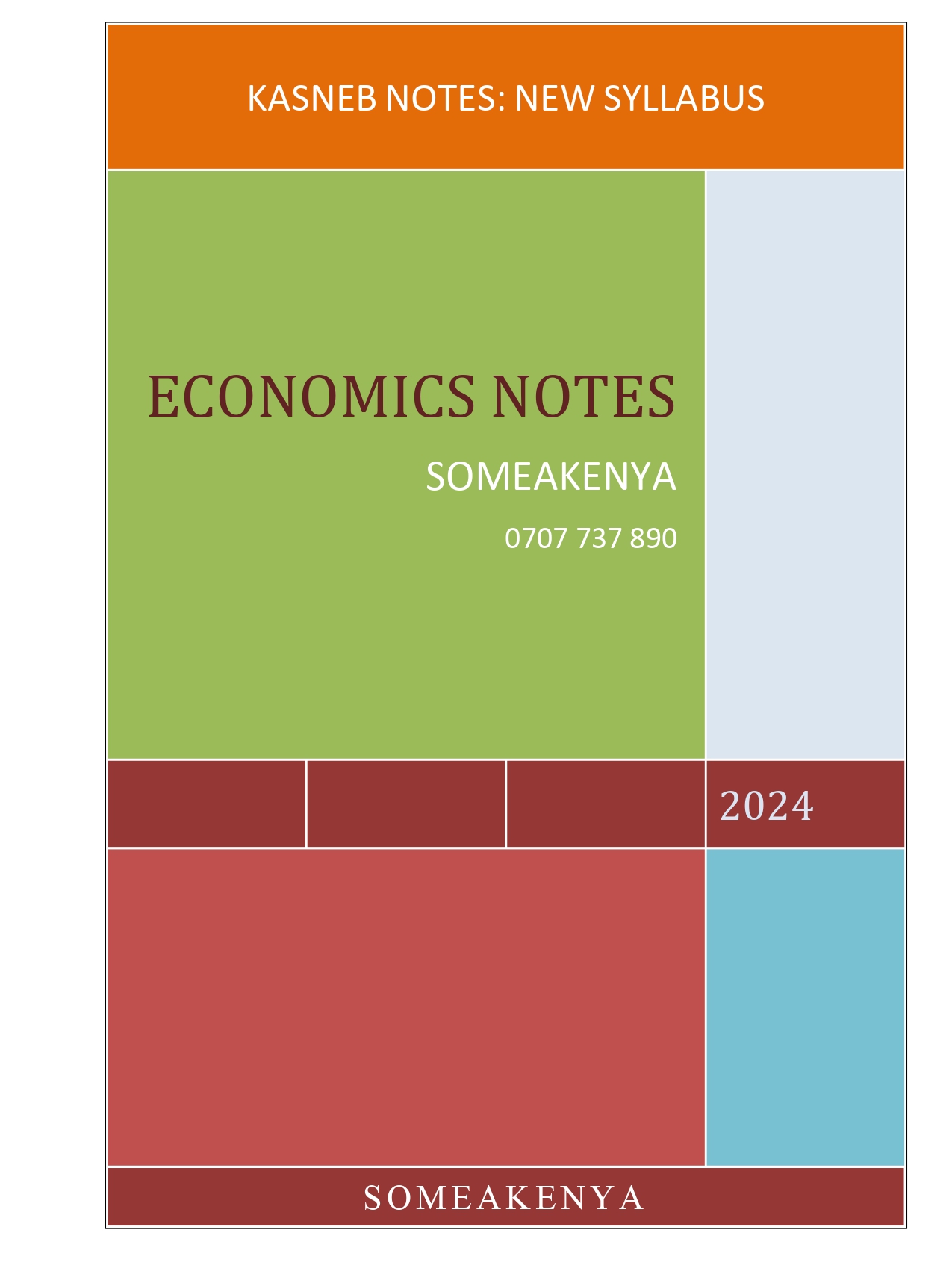
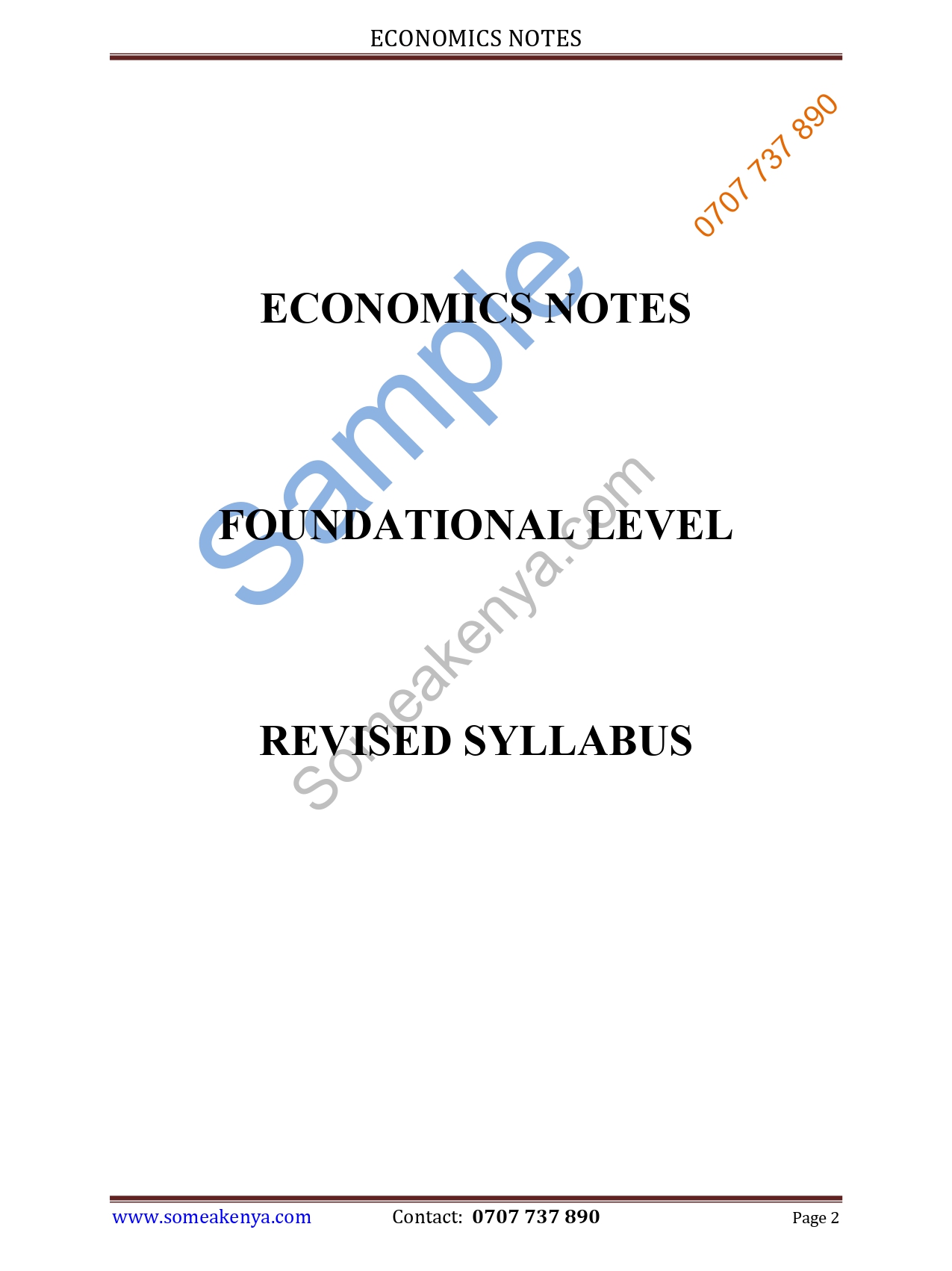
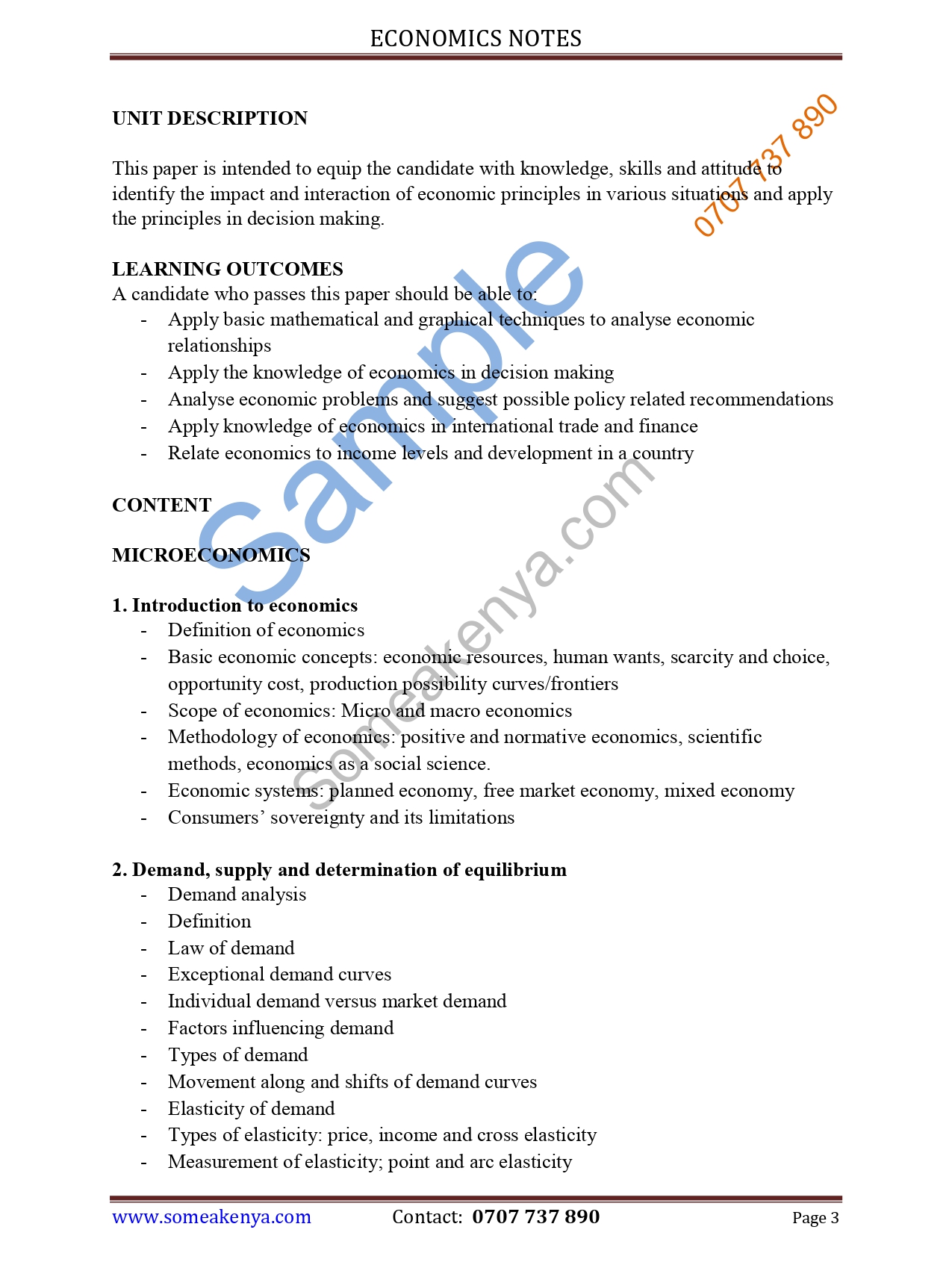
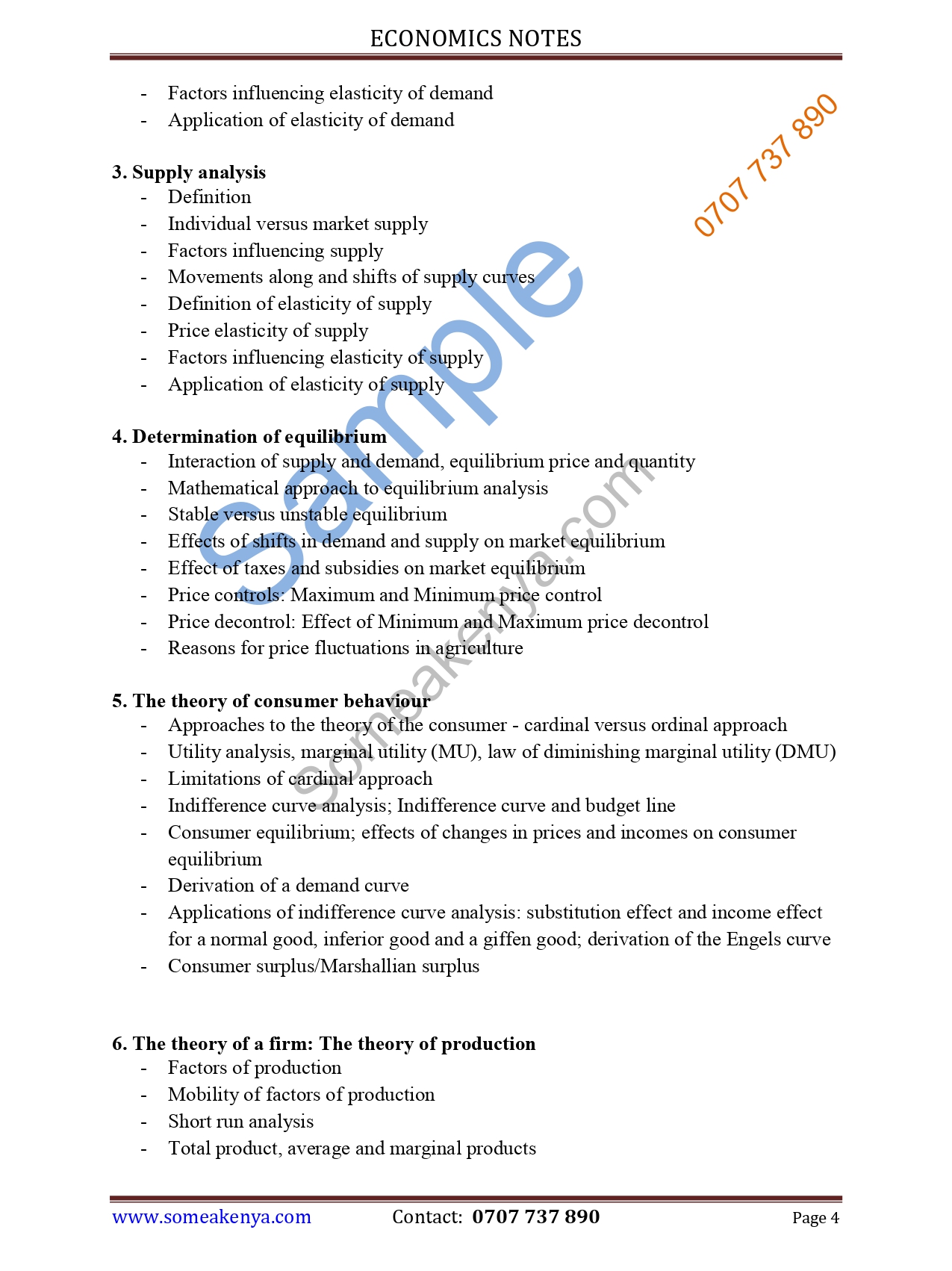
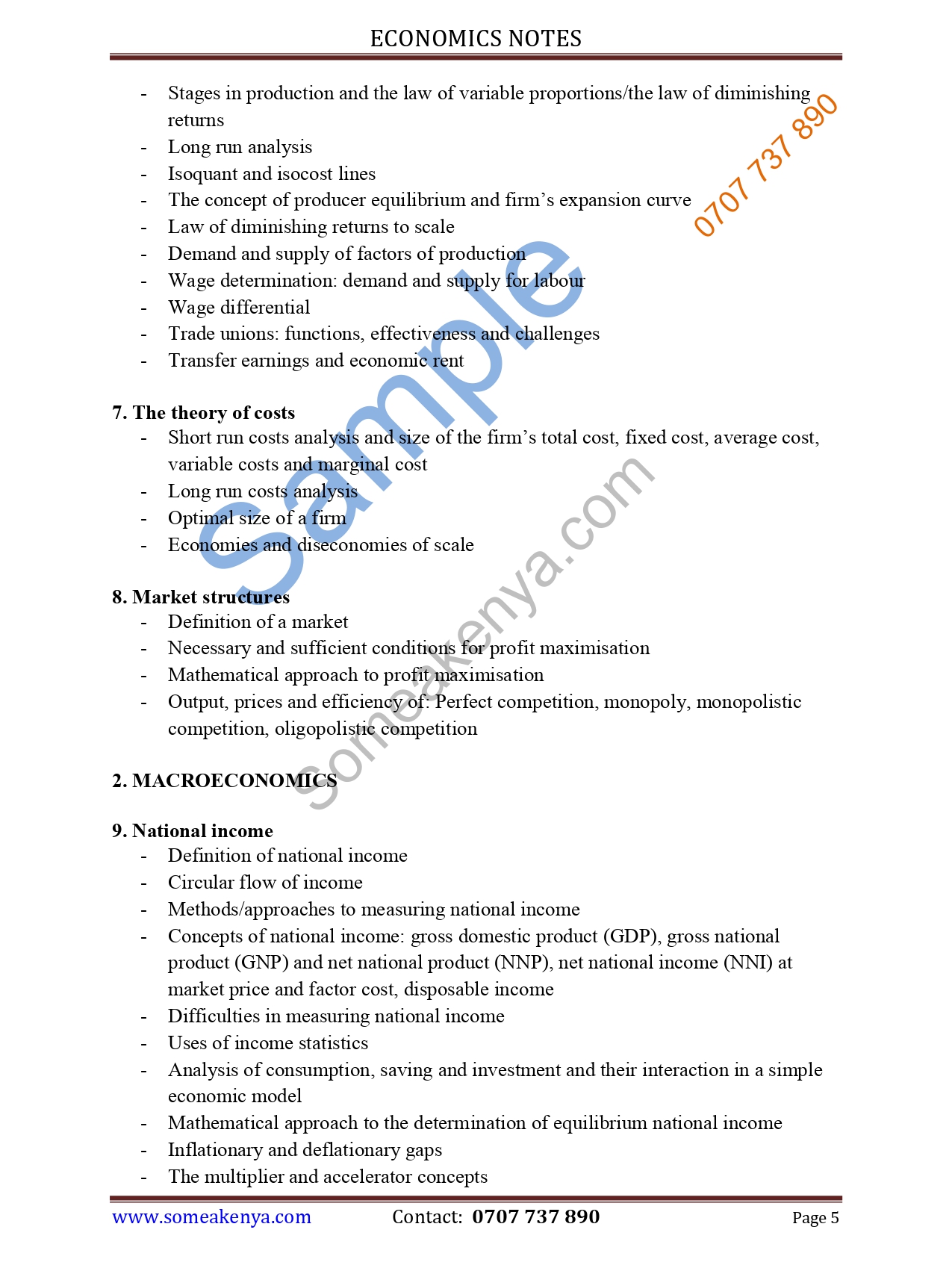
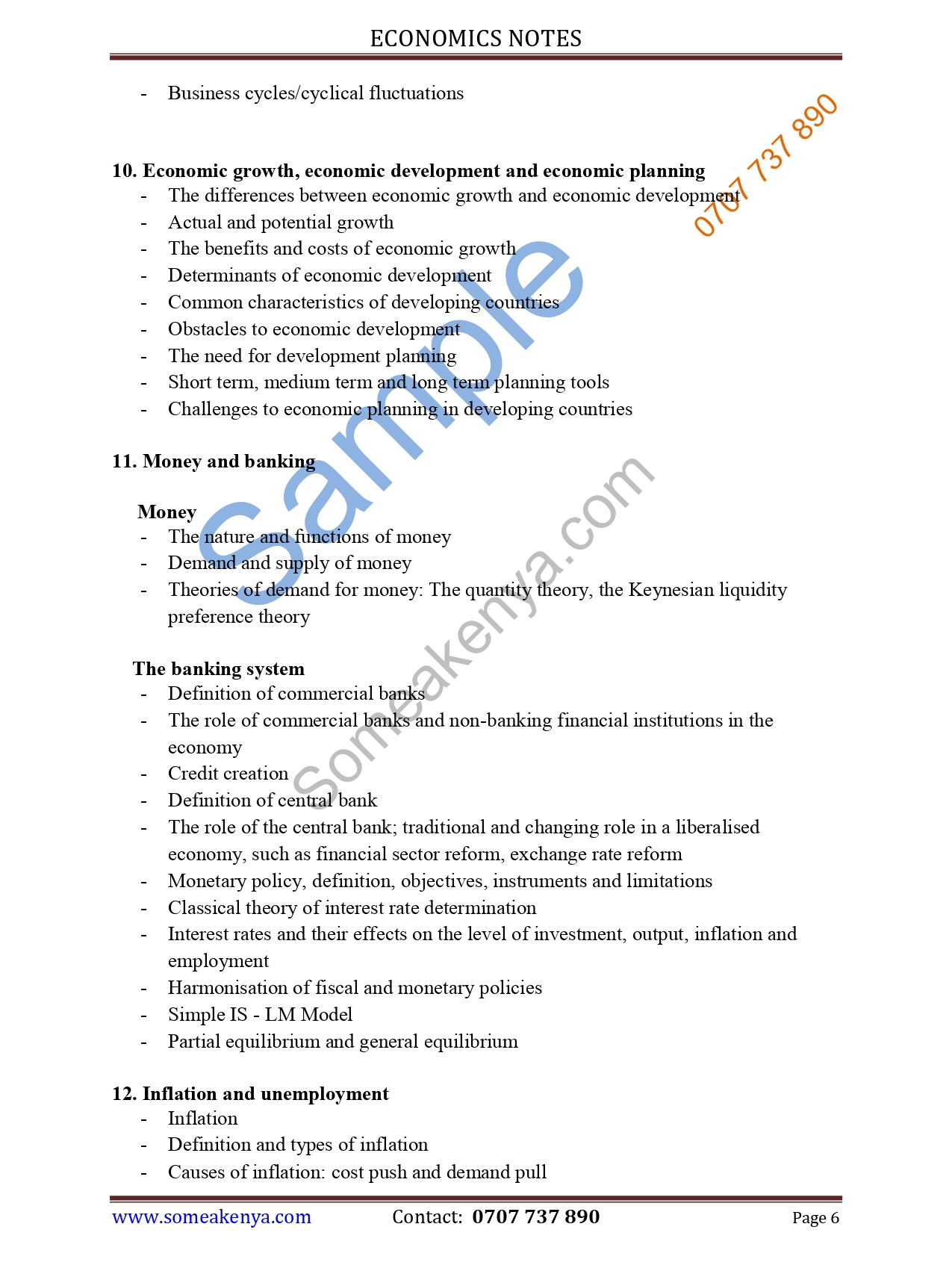
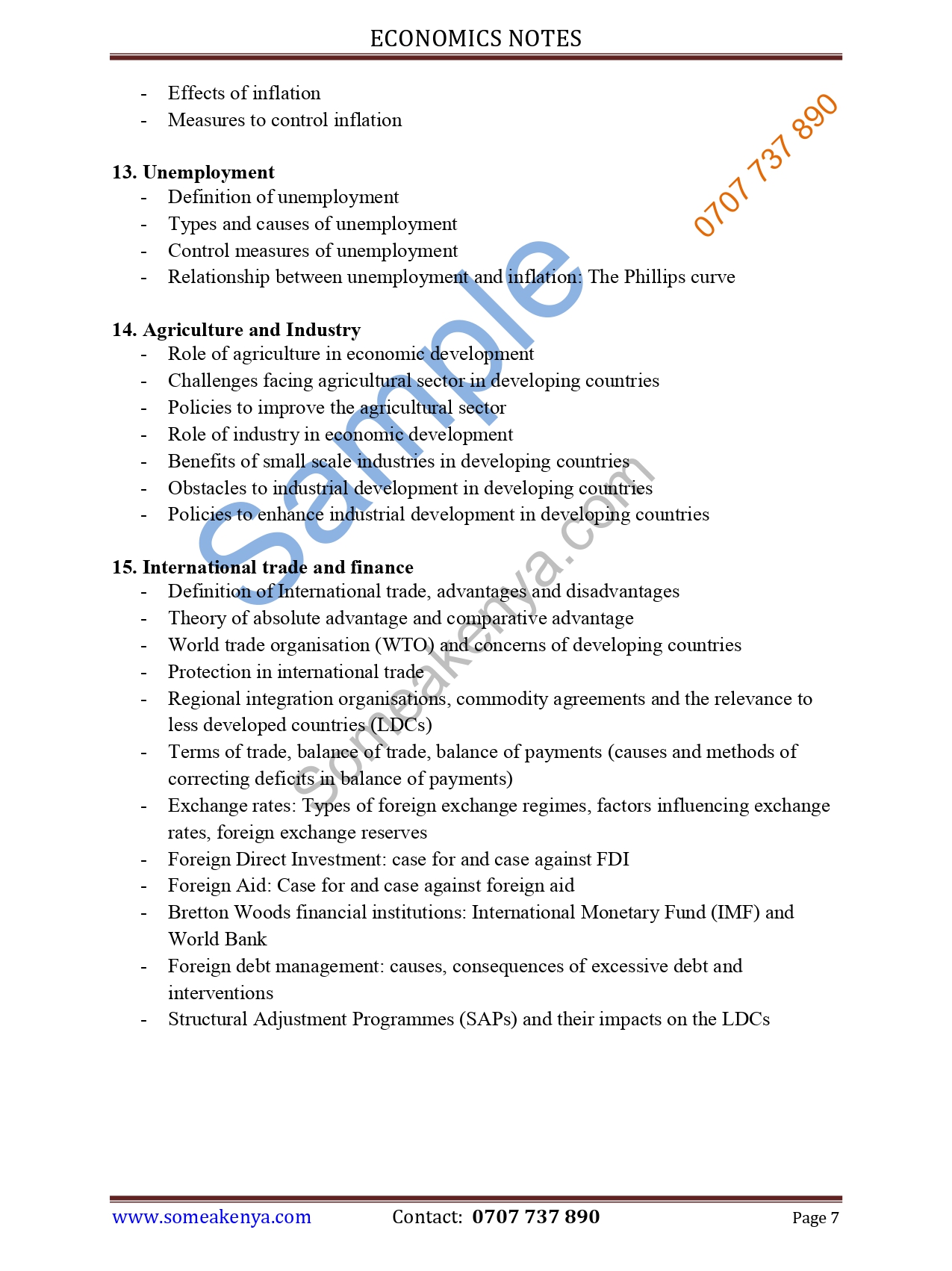

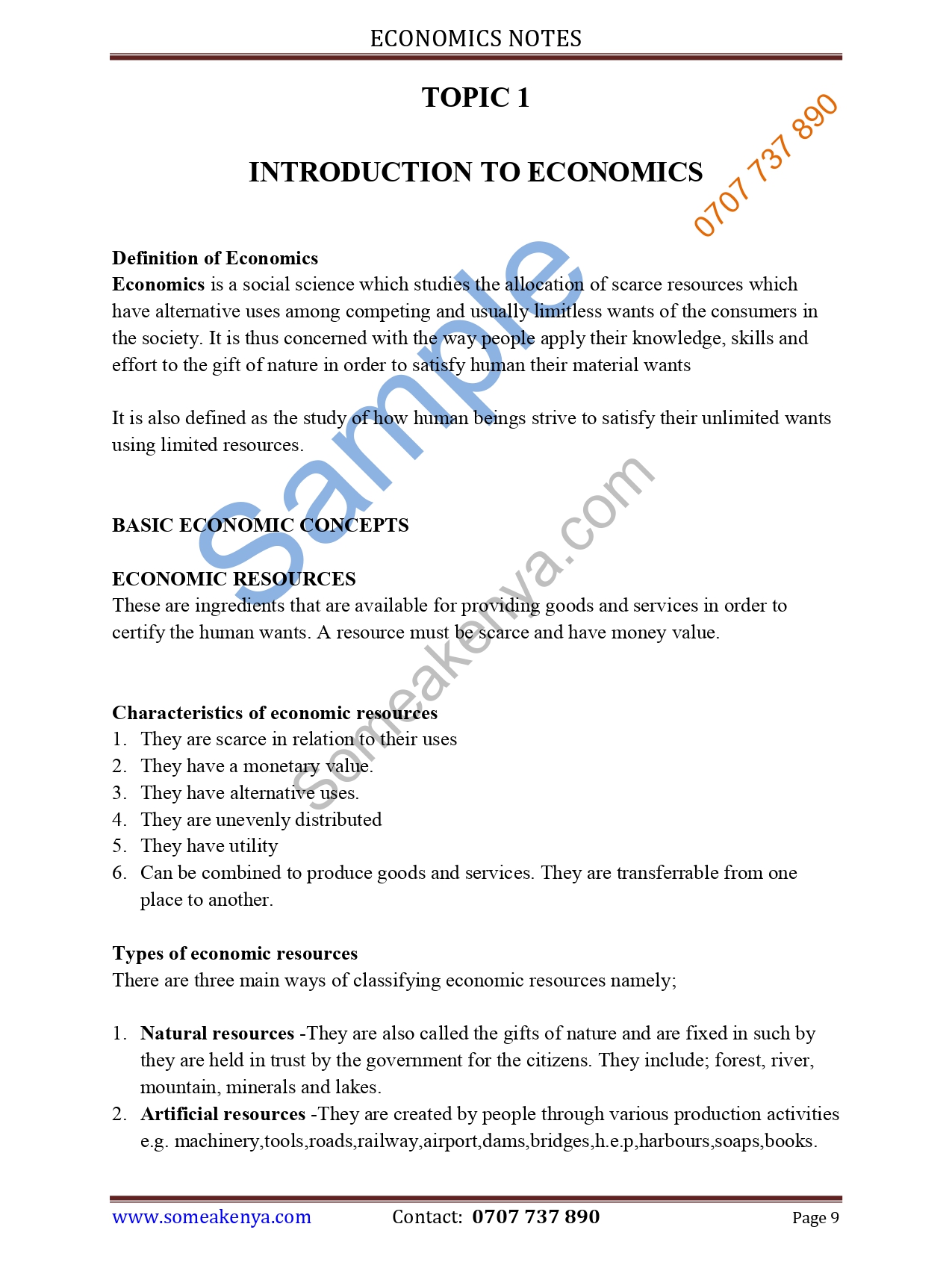




Full Access to these notes/Kit on Desktop/Laptop via https://desktop.someakenya.co.ke
Or through Our Mobile App
Topics covered
MICROECONOMICS
- Introduction to economics
- Definition of economics
- Basic economic concepts: economic resources, human wants, scarcity and choice, opportunity cost, production possibility curves/frontiers
- Scope of economics: Micro and macro economics
- Methodology of economics: positive and normative economics, scientific methods, economics as a social science.
- Economic systems: planned economy, free market economy, mixed economy
- Consumers’ sovereignty and its limitations
- Demand, supply and determination of equilibrium
- Demand analysis
- Definition
- Law of demand
- Exceptional demand curves
- Individual demand versus market demand
- Factors influencing demand
- Types of demand
- Movement along and shifts of demand curves
- Elasticity of demand
- Types of elasticity: price, income and cross elasticity
- Measurement of elasticity; point and arc elasticity
- Factors influencing elasticity of demand
- Application of elasticity of demand
- Supply analysis
- Definition
- Individual versus market supply
- Factors influencing supply
- Movements along and shifts of supply curves
- Definition of elasticity of supply
- Price elasticity of supply
- Factors influencing elasticity of supply
- Application of elasticity of supply
- Determination of equilibrium
- Interaction of supply and demand, equilibrium price and quantity
- Mathematical approach to equilibrium analysis
- Stable versus unstable equilibrium
- Effects of shifts in demand and supply on market equilibrium
- Effect of taxes and subsidies on market equilibrium
- Price controls: Maximum and Minimum price control
- Price decontrol: Effect of Minimum and Maximum price decontrol
- Reasons for price fluctuations in agriculture
- The theory of consumer behaviour
- Approaches to the theory of the consumer – cardinal versus ordinal approach
- Utility analysis, marginal utility (MU), law of diminishing marginal utility (DMU)
- Limitations of cardinal approach
- Indifference curve analysis; Indifference curve and budget line
- Consumer equilibrium; effects of changes in prices and incomes on consumer equilibrium
- Derivation of a demand curve
- Applications of indifference curve analysis: substitution effect and income effect for a normal good, inferior good and a giffen good; derivation of the Engels curve
- Consumer surplus/Marshallian surplus
- The theory of a firm: The theory of production
- Factors of production
- Mobility of factors of production
- Short run analysis
- Total product, average and marginal products
- Stages in production and the law of variable proportions/the law of diminishing returns
- Long run analysis
- Isoquant and isocost lines
- The concept of producer equilibrium and firm’s expansion curve
- Law of diminishing returns to scale
- Demand and supply of factors of production
- Wage determination: demand and supply for labour
- Wage differential
- Trade unions: functions, effectiveness and challenges
- Transfer earnings and economic rent
- The theory of costs
- Short run costs analysis and size of the firm’s total cost, fixed cost, average cost, variable costs and marginal cost
- Long run costs analysis
- Optimal size of a firm
- Economies and diseconomies of scale
- Market structures
- Definition of a market
- Necessary and sufficient conditions for profit maximisation
- Mathematical approach to profit maximisation
- Output, prices and efficiency of: Perfect competition, monopoly, monopolistic competition, oligopolistic competition
- MACROECONOMICS
- National income
- Definition of national income
- Circular flow of income
- Methods/approaches to measuring national income
- Concepts of national income: gross domestic product (GDP), gross national product (GNP) and net national product (NNP), net national income (NNI) at market price and factor cost, disposable income
- Difficulties in measuring national income
- Uses of income statistics
- Analysis of consumption, saving and investment and their interaction in a simple economic model
- Mathematical approach to the determination of equilibrium national income
- Inflationary and deflationary gaps
- The multiplier and accelerator concepts
- Business cycles/cyclical fluctuations
- Economic growth, economic development and economic planning
- The differences between economic growth and economic development
- Actual and potential growth
- The benefits and costs of economic growth
- Determinants of economic development
- Common characteristics of developing countries
- Obstacles to economic development
- The need for development planning
- Short term, medium term and long term planning tools
- Challenges to economic planning in developing countries
- Money and banking
Money
- The nature and functions of money
- Demand and supply of money
- Theories of demand for money: The quantity theory, the Keynesian liquidity preference theory
The banking system
- Definition of commercial banks
- The role of commercial banks and non-banking financial institutions in the economy
- Credit creation
- Definition of central bank
- The role of the central bank; traditional and changing role in a liberalised economy, such as financial sector reform, exchange rate reform
- Monetary policy, definition, objectives, instruments and limitations
- Classical theory of interest rate determination
- Interest rates and their effects on the level of investment, output, inflation and employment
- Harmonisation of fiscal and monetary policies
- Simple IS – LM Model
- Partial equilibrium and general equilibrium
- Inflation and unemployment
- Inflation
- Definition and types of inflation
- Causes of inflation: cost push and demand pull
- Effects of inflation
- Measures to control inflation
- Unemployment
- Definition of unemployment
- Types and causes of unemployment
- Control measures of unemployment
- Relationship between unemployment and inflation: The Phillips curve
- Agriculture and Industry
- Role of agriculture in economic development
- Challenges facing agricultural sector in developing countries
- Policies to improve the agricultural sector
- Role of industry in economic development
- Benefits of small scale industries in developing countries
- Obstacles to industrial development in developing countries
- Policies to enhance industrial development in developing countries
- International trade and finance
- Definition of International trade, advantages and disadvantages
- Theory of absolute advantage and comparative advantage
- World trade organisation (WTO) and concerns of developing countries
- Protection in international trade
- Regional integration organisations, commodity agreements and the relevance to less developed countries (LDCs)
- Terms of trade, balance of trade, balance of payments (causes and methods of correcting deficits in balance of payments)
- Exchange rates: Types of foreign exchange regimes, factors influencing exchange rates, foreign exchange reserves
- Foreign Direct Investment: case for and case against FDI
- Foreign Aid: Case for and case against foreign aid
- Bretton Woods financial institutions: International Monetary Fund (IMF) and World Bank
- Foreign debt management: causes, consequences of excessive debt and interventions
- Structural Adjustment Programmes (SAPs) and their impacts on the LDCs
TOPIC 1
INTRODUCTION TO ECONOMICS
Definition of Economics
Economics is a social science which studies the allocation of scarce resources which have alternative uses among competing and usually limitless wants of the consumers in the society. It is thus concerned with the way people apply their knowledge, skills and effort to the gift of nature in order to satisfy human their material wants
It is also defined as the study of how human beings strive to satisfy their unlimited wants using limited resources.
BASIC ECONOMIC CONCEPTS
ECONOMIC RESOURCES
These are ingredients that are available for providing goods and services in order to certify the human wants. A resource must be scarce and have money value.
Characteristics of economic resources
1. They are scarce in relation to their uses
2. They have a monetary value.
3. They have alternative uses.
4. They are unevenly distributed
5. They have utility
6. Can be combined to produce goods and services. They are transferrable from one place to another.
Types of economic resources
There are three main ways of classifying economic resources namely;
1. Natural resources -They are also called the gifts of nature and are fixed in such by they are held in trust by the government for the citizens. They include; forest, river, mountain, minerals and lakes.
2. Artificial resources -They are created by people through various production activities e.g. machinery,tools,roads,railway,airport,dams,bridges,h.e.p,harbours,soaps,books.
3. Human resources-They are mental/physical efforts offered by people to the production society. These efforts cannot be separated from their providers e.g. teaching, health services, mechanics, carpentry, engineers etc.
Natural Resources refer to anything given by God or nature such as fertile soil, rivers, lakes, mountains etc.
Man Made Resources refers to anything created by man to assist in further production such as tools, equipment’s, roads and buildings etc.
HUMAN WANTS
This are basic needs that human beings need to function normally this include; food, shelter, clothing and air. Things like radio, education, watches, and vehicles are not very basic. They are meant to have an individual have a happy and comfortable and luxurious life.
• Form utility – This is created through changing the form of a raw material to a finished product. It is usually done during various manufacturing processes. The finished goods are in a better form for use than the raw materials.
• Time utility – this is created through warehousing or storage
• Possession utility – This is created through trade or exchange.
• Place utility – this is created through distribution. After goods have been produced, they must be moved to the places where they are required for use.
Characteristics of human wants
1. They are many, numerous and unlimited.
2. They continually change with time and other factors.
3. Some are repetitive e.g. supper, lunch etc.
4. Wants are competitive
5. Wants are complementary-Used together e.g. shoe polish and a shoe.
6. Wants are habitual that they always occur e.g. toothpaste, perfume etc.
7. Wants are universal-Everybody wants them.
Characteristics of basic wants
1. One can’t do without them.
2. They are felt needs
3. Can’t be postponed
4. They are satisfied before secondary wants.
Difficulties in satisfying human wants
Although human wants are there to satisfy man with lives requirements, it is not always possible to have them this is because;
• They are too many and new ones keep cropping up.
• Resources to satisfy them are never enough (limited).
• They are repetitive hence people will always strive for more resources.
• They continually change with time and other factors like age and gender.
• Some are habitual making life unbearable without them.
• Due to scarcity of resources, a problem of deciding which want to satisfy first with scarce resources arise.
Types of human wants
They are classified into two groups.
1. Basic human needs-This are things one cannot do without e.g. food. They always come at the top for the scale of preference and failure to satisfy them one can lead a miserable life or even die.
2. Secondary human wants-they are things one cannot do without. They help one lead a happy meaningful and comfortable life e.g. TV set, radio, cars, education, sodas etc.
NB: One must satisfy basic needs before attaining secondary wants.
Since the resources to satisfy human wants are scarce, one has to select on what wants are to be satisfied first and which can wait.
SCARCITY AND CHOICE
Scarcity and Choice if the resources available are not enough to produce goods and services to satisfy all the wants then they are said to be scarce. As a result, individuals and society cannot have all the things that they want. Since resources are limited, choices have to be made. The choice to satisfy one want implies others are forgone. Individuals have to make choices e.g. consumers with their limited income and unlimited wants have to choose how they spent their income.
Importance of scarcity
i. Makes people to work hard
ii. Stimulates usage of available resources
OPPORTUNITY COST
Opportunity Cost refers to the value of benefit expected from the best second alternative forgone. It is based on the fact that resources being scarce have competing alternative uses. The choice to satisfy one alternative means that another is forgone. The value of the second best forgone alternative is the opportunity cost.
Utility-this is the quality of that commodity that satisfies human want.
Economics-subject/discipline
Economy-this is the country’s financial position.
Economies-this are the benefits of large scale.
Ceteris paribus – this is a major concept meaning, other factors held constant
Pareto efficiency – this is a situation in which it is not possible to make someone better off without making someone worse off.
Consumer sovereignity – this refers to the freedom of individuals and households to decide for themselves what they want to buy in a given market.
PRODUCTION POSSIBILITY FRONTIER/CAPACITY (PPF/PPC)
It provides a graphical illustration of the problem of scarcity and choice which is the basic economic problem. The curve shows what a country produces with existing supply of land, capital and entrepreneurship ability. With limited supply of economics resources a country has a wide variety of options and variety of goods and services it can produce. Assume a simple hypothetical economy where a country produces two types of goods i.e. agriculture and manufactured goods. The two extreme possibilities are:
a) The country commits all its resources to the production of agriculture and non to manufacturing.
b) All the resources are put to manufacture and none to agriculture.
These two extreme cases are unlikely and the country will most likely choose to produce goods of both commodities. The opportunity cost of producing either of them is increasing which the law of diminishing return.
SCOPE OF ECONOMICS
The main branches of economics are:
1. Microeconomics
This is the study of the smallest economic decisions making units of the society. Microeconomics theory is a branch of economics that studies the behavior of individual decision making units such as consumers, resource owners and business firm as well as individual markets in a free market economy. The aim of microeconomics is to explain the determination of prices and quantities of individual goods and services.
Microeconomics also considers the impact of government regulation and taxation of individual markets. For example, microeconomics analyses the forces that determine the prices and quantities of television sets sold. Microeconomics can be considered as the ultimate cellular structure of economics. It is the study of individuals, households and firms. The major areas are demand and supply analysis , market equilibrium ,consumer theory , theory of the firm , market structure and distribution theory
2. Macroeconomics
This is the study of bigger and complex systems. Macroeconomic theory is the study of the behavior of the economy as a whole whereby the relationship is considered between broad economic aggregates such as national income, employment and prices. The economy is disaggregated into broadly homogenous categories and determinants of the behavior of these aggregates are integrated to provide a model to the entire economy.
Macroeconomics focuses on the economic stabilization whereby government policy is used to moderate business cycles and encourages real economic growth.
Macroeconomics became a separate topic of discussion in the aftermath of John Maynard Keynes and the great depression. The line between microeconomics and macroeconomics is, however, blurred and there are many areas of overlap between the two. Key areas of macroeconomics are: national income ,economic growth and development , money and banking , public finance unemployment ,inflation and international trade
Why Study Economics?
It is useful to study economics for the following reasons
i. Economics provides the underlying principles of optimal resource allocation and thus enables individuals and firms to make economically rational decisions. Thus for example the preparation of budgets involves knowledge of demand and elasticity analysis. The making of price policy decisions draws heavily on the concept of elasticity in economics. Additionally, the theory of production in economics is concerned with the principles that facilitate the optical combination factors of production.
ii. A study of economics enables individuals and organizations to appreciate the constraints imposed by the economic environment within which any entity operates. Thus an individual or firm is more fully enabled to appreciate the implications of the annual budget considering how for example the increased liberation of the economy will affect a particular business entity and the economy in general. Additionally, the student of economics is able to appreciate the effects of such economic variables as inflation, exchange rates, interest rates money supply and so on.
iii. The area of development economics is fundamentally concerned with the reasons why societies develop and means of accelerating development. It is vital for individuals as citizens to appreciate the parameters that determine the development process so that they contribute more fully to facilitate and contribute to solving the economic problems that characterize their society.
iv. Economics is an analytical subject and its study can help develop logical reasoning which is never superfluous.
v. It is an examinable and mandatory for students perusing business courses
vi. Students appreciate the effect of economic variables e.g. inflation, exchange rate, interest rate, money and supply etc.
THE METHODOLOGY OF ECONOMICS
The methodology used in studying and applying economics can be divided into three.
This are basically the methods of solving economic problems.
1. Positive economics is concerned with what is, or how the economic problem facing societies are actually solved. it deals with facts using positive statements. for example; “Kenya is a member of the East African community” and “Uganda is currently Kenya’s major trading partner” are positive statements. For example a dispute over whether Uganda is currently Kenya’s major trading partner can be settled by looking at the statistics of Kenya’s trade with its partners.
2. Normative economics refers to the part of economics that deals with the value of judgments. This implies that normative deals with what ought to be, or how the economic problems facing the society should be solved. Normative statements usually reflect people’s moral attitudes and are expressions of what particular individuals group thinks ought to be done. A statement such as “Uganda to should join the Southern Africa Development Community” or “upper income classes ought to be taxed heavily”, are normative statements.
3. Scientific method: Economics make use of scientific method to develop theories. Inquiry is generally confined to positive questions. One of the major objectives of sciences is to develop theories. A theory is a general or unifying principle that describes and explains the relationship between things observed in the world around us. The purpose of a theory is to predict and explain. The search for a theory begins whenever a regular pattern is observed in the relationship between two or more variables and one asks why this should is so. A theory refers to a hypothesis that has been successfully tested. It is important to note that economics hypothesis is not tested by realism of its assumptions but its ability to predict accurately and explain. The following procedures are adopted in the scientific method:
a) The concepts are defined in such a way that they can be measured in order to be able to test the theory against the facts.
b) A hypothesis formulated.
c) The hypothesis is then used to make predictions.
d) The hypothesis is tested by considering whether its predictions are supported by facts.
METHODOLOGY OF ECONOMICS
POSITIVE AND NORMATIVE ECONOMICS
Economics is a science as well as art. But which type of science is a big question here, i.e. positive or normative? Positive economics is related to the analysis which is limited to cause and effect relationship. On the other hand, normative economics aims at examining real economic events from the moral and ethical point of view. It is used to judge whether the economic events are desirable or not.
While Positive economics is based on facts about the economy. Normative economics is value judgment based. Most of the people think that the statements which are commonly accepted are a fact but in reality, they are valued. By, understanding the difference between positive and normative economics, you will learn about how the economy operates and to which extent the policy makers are taking correct decisions.
Definition of Positive Economics
Positive Economics is a branch of economics that has an objective approach, based on facts. It analyses and explains the casual relationship between variables. It explains people about how the economy of the country operates. Positive economics is alternatively known as pure economics or descriptive economics.
When the scientific methods are applied to economic phenomena and scarcity related issues, it is positive economics. Statements based on positive economics considers what’s actually occurring in the economy. It helps the policy makers to decide whether the proposed action, will be able to fulfill our objectives or not. In this way, they accept or reject the statements.
Definition of Normative Economics
The economics that uses value judgments, opinions, beliefs is called normative economics. This branch of economics considers values and results in statements that state, ‘what should be the things’. It incorporates subjective analyses and focuses on theoretical situations.
Normative Economics suggests how the economy ought to operate. It is also known as policy economics, as it takes into account individual opinions and preferences. Hence, the statements can neither be proven right nor wrong.
Key Differences between Positive and Normative Economics
The important differences between positive and normative economics are explained in the points given below:
1. Positive Economics refers to a science which is based on data and facts. Normative economics is described as a science based on opinions, values, and judgment.
2. Positive economics is descriptive, but normative economics is prescriptive.
3. Positive economics explains cause and effect relationship between variables. On the other hand, normative economics pass value judgments.
4. The perspective of positive economics is objective while normative economics have a subjective perspective.
5. Positive economics explains ‘what is’ whereas normative economics explains ‘what should be’.
6. The statements of positive economics can be scientifically tested, proved or disproved, which cannot be done with statements of normative economics.
7. Positive economics clearly define economic issues. Unlike normative economics, in which the remedies are provided for the economic issues, on the basis of value judgment.
SCIENTIFIC METHODS
Economics proceeds as an evolutionary discipline, looking at data, developing hypotheses, testing them and reaching sometimes uneasy consensus on how the economy works. This is called the scientific method which begins with the formulation of a theory about behaviour. For example, we may put forward the idea that the demand for a good is determined by its price. On the basis of this we may reason that as the price is increased, demand goes down, while if the prices are decreased the demand will go up. This then gives us a hypothesis which can be tested on observed behaviour. This testing of ideas on the evidence is known as empiricism.
Ceteris paribus
The economic world is extremely complicated. There are millions of people and firms; thousands of prices and industries. One possible way of figuring out economic laws in such a setting is by controlled experiments. A controlled experiment takes place when everything else but the item under investigation is held constant. This is an essential component of scientific method.
However economists have no such luxury when testing economic laws. Therefore, when formulating economic principles economists are usually careful to state that such and such will happen, ceteris paribus which is the Latin expression meaning all other things remaining constant.
ECONOMICS AS A SOCIAL SCIENCE
The term Social Science refers any subject that deals with human behaviour. Political Science, Psychology, Ethics, etc. come within the definition of Social Science.
Economics is a social science because it deals with one aspect of human behaviour, – how men deal with problems of scarcity. Samuelson says that Economics is “the queen of the social sciences”.
Economics deals with human beings living in a society, i.e., in a large group of persons with touching interests and problems. It does not deal with problems of solitary individuals like Robinson Crusoe. In a community of people everybody is influenced by the actions of the others.
Economics deals with the activities of people, living in an organised community or society, in so far as such activities are related to the earning and use of wealth or with the problems of scarcity, choice and exchange. Economics is, there¬fore, considered to be a branch of sociology which is a study of the history and nature of society. As a consequence of this we find that economics is closely related to the other social sciences like Ethics, Political Science, and History etc.
ECONOMIC SYSTEMS
These refer to the way in which different societies solve the three different basic economic problems which are: which goods should be produced and in what quantities?
1. How should various goods and services be produced?
2. How should various goods and services be distributed?
To answer this question, various political and economic structures have been put in place, whereby we have;
a) Planned economy/command/government controlled/socialism/communism
It refers to an economic system where the crucial decisions are determined a body appointed by the state. The body takes up the role of mechanism which prevails in a free market economy
Features of a command economy
1. Leadership and control of economies. All important means of production (resources) are publicly owned such as land, power generation, housing among others.
2. Rationing of certain commodities if supply of such fall below demand.
3. Existence of production targets for different sectors of the economy. The government determines how resources are allocated through planning.
4. Fixing of prices and wages
5. Occasional existence of restricted labor market in which workers take up jobs assigned to them.
6. Government decides what is to be produced, how it will be produced and for whom to produce.
Advantage of planned economy
1. Avoids economic instability
2. Minimize negative externalities
3. Makes adequate provision of public and merit goods ie education, health and safety.
4. Facilitate the shift of resources in pursuant of grand schemes such rapid industrialization
5. Puts checks on monopoly power which are controlled by state monopolies (Parastatals).
6. Ensures there is full employment.
7. Low inflation rate is being experienced.
8. Minimum waste of resources.
9. Minimum inequalities of wealth and income
10. Easier government control.
Disadvantages of Planned economy
1. There is wastage of resources in production because consumers demand is judged in advance without the use of price mechanism.
2. The cost of gathering information for planning is expensive to the state.
3. There is no individual incentives and initiative for hard work and innovation.
4. The power of consumer sovereignty is curtailed.
5. There is no incentive for hard work and this discourages the suppliers
6. Some resources may end up being underutilized
7. Difficulty in estimating demand due to different time frames i.e. Decembers and end month and sometimes during certain occasions such as valentine demand tends to rise.
b) Free market/capital system/laser faire economy
It refers to a system where decisions about allocation of resources are made by individuals on the basis of prices generated by forces of market prices of demand and supply.
Features /Characteristics
1. Private property individuals have the right to own or dispose off their property as they may consider it fit.
2. Freedom of choice and enterprise Individuals have the right to buy or hire economic resources, organize them for production purpose and sell them in the market of their choice. Such persons are referred to as entrepreneurs.
3. Self interest in the pursuant of personal goals. The individuals are free to do as they wish and have the motive of economic activity in self-interest.
4. Competition There is a large number of buyers and sellers such that each buyer and seller accounts for but is insignificant to influence the supply and demand and hence prices.
5. Reliance on price mechanism .This is an elaborate system of commerce in which numerous choices of consumers and producers are aggregated and balanced against each other. The interaction of demand and supply determine prices.
6. No government intervention hence no price controls, taxes and subsidies.
7. There are property rights provided and enhanced by the government through copy rights patents, trademarks etc. e.g. on innovating and inventing one is protected from absorption and thus you enjoy the benefits.
8. There is excessive advertising.
Advantages of free market economy
1. There is the matching of demand and supply. Production takes place in response to demand hence a balance between what is produced and consumed. No wastage.
2. There is flexibility of the market in responding to changes in demand and supply conditions thus variety products are offered.
3. There are no resources wasted in planning as no planning is required
4. Consumer sovereignty and competition gives rise to a wide variety of goods and services giving consumers a wide range to choice from.
5. Higher rates of economic growth due to the incentive available for hard work which is motivated by profits.
6. No wastage of resources on unrealistic projects because investment decision are based on profits.
7. The costs associated with government bureaucracy are highly reducing encouraging entrepreneurship in the economy.
8. Better quality products are produce due to innovation and inventions
9. Intensive innovation and invention is prevalent due to competition.
10. Affordable prices of products.
Disadvantages of free market economy
1. Income inequality the ability of some people and firms to acquire excessive market power leads to greater inequality in income and wealth.
2. There is likelihood of developing Monopoly powers whereby one firm controls the production and distribution of commodities.
3. The price mechanism on its own cannot allocate resources to production of public goods e.g. schools, security etc.
4. Instability in economy and unemployment. This is due to trade cycle i.e. recession, depression, recovery and boom.
5. The inability to deal with structural changes caused by wars, natural calamities among others.
6. Inadequate provision of merit goods. Merit goods are goods of importance to the community such as health, education, security among others
7. Due to excessive advertising consumers are likely to make irrational choices at the expense of moral life/health
8. Over-exploitation of resources
(c) Mixed economy
Refers to an economic system where resource allocation is determined by the state-i.e. the government and price mechanism. Both the government and private sector have a role to play in resource allocation. it is widely adopted in many countries and results varied depending on nature of the economy. The government normally intervenes when the private sector of market fails to allocate resources effectively as long as the objective of the economic growth and development is achieved.
Advantages of mixed economic systems
1. Optimal utilization of nations resources
2. Relatively wider tax base
3. Consumers are protected from consumption of harmful products
4. A considerable degree of consumer sovereignity.
5. High quality products and services due to competition
6. More equal distribution /allocation of resources.
7. Relatively stable prices.
Role of government
1. Checking quality of products.
2. Offering government subsidies
3. Offering import and export tariffs.
4. Ensuring price controls
5. Foreign exchange market
6. Taxation by ensuring there is redistribution of income through a system of taxation.
7. To create a framework of regulations and rules to ensure fair competition thus promoting competition between firms both small and big ones.
8. Government intervention can prevent market failures in price mechanism.
9. Stabilization of the economy.
10. The government is able to maintain competition by controlling monopoly power.
CONSUMERS’ SOVEREIGNTY AND ITS LIMITATIONS
Consumer sovereignty is the idea that it is consumers who influence production decisions. The spending power of consumers means effectively they ‘vote’ for goods. Firms will respond to consumer preferences and produce the goods demanded by consumers. It is a manifestation of the ‘invisible hand’
Others argue that consumer sovereignty is a myth. Firms produce goods and use marketing techniques to sell consumers good they don’t really need or want.
In practice, there is an element of both. Firms may market new goods successfully like an iPod. But, if consumers are not impressed the good will not sell. There are countless new products, which never catch off.
Consumer sovereignty and free markets
• In a free market, consumers have greater levels of consumer sovereignty.
• In command economies, goods are produced according to state dictates so there is no consumer sovereignty.
Consumer sovereignty and health care
In some markets, it is much harder to cater to consumer sovereignty because of lack of knowledge. Doctors rarely offer patients meaningful choices. But, prescribe drugs and treatment based on their knowledge. Also, patients don’t get to choose between different doctors or hospitals but go to the one prescribed by private insurance or the state provided health care.
You can, in theory, have a degree of choice, but in practice, it is a very different market – to save choosing a meal.
Consumer sovereignty and behavioural economics
Traditional economic theory assumes consumers seek to maximise utility. The equimarginal principle suggests consumers weigh up the marginal benefit of different goods, and choose a combination of goods which maximises total utility.
However, behavioural economics suggests this model is unrealistic. In practice, individuals do not have the time or the inclination to rationally weigh up different options. Instead, we use heuristics and rough rules of thumb to take quick decisions. Also, individuals are heavily influenced by psychological factors, such as:
• Choice architecture. Strategic placement of goods by firms can influence our decisions, e.g. we are much more likely to choose the default option, then make an effort to change. Firms can use this to sign us up for newsletters or insurance.
• Loss aversion. We dislike losing what we already have and we go to great lengths to avoid losses.
• Nudges – subtle nudges can encourage us to buy what is suggested – ‘Would you like fries with that?” – Definitely encourages more people to buy extras.
LIMITATIONS OF CONSUMERS’ SOVEREIGNTY
The ability and freedom of the consumer to determine the fundamental resource allocation decisions is limited by the following factors:
1. Nature of the economic system – In general, the consumer is more sovereign in a free market oriented system where commodities are produced more in line with consumer preferences. In a planned economic system less regard is given for consumer preferences since what is produced is determined by a Central Planning Authority.
2. Size of the consumer’s income – The power to determine what is to be produced depends on the amount of income that an individual consumer earns. The consumers who earn more are able to exercise more of this power since they are capable of bidding up prices of the type of goods they want; the demand of the low income earners is relatively less effective in influencing resource allocation. Thus, the larger the consumer’s income the greater is the consumer’s sovereignty since the consumer can afford to choose from a wider range of goods and services which he can buy. Consumer sovereignty is, however, always limited to some extent by the level of income and especially since wants are unlimited.
3. Range of goods available – Depending on the technology available and ownership of productive resources, consumers depend on the goods actually available in the market to satisfy their wants. They cannot therefore reflect their preferences through price bidding of the required products since such products may after all not be available in the market. The level of production may lag behind consumer’s desires and therefore what is produced is not in accordance with the nature of tastes and preferences. Different consumers have very different individual tastes and preferences and it is difficult for the available range of goods and services to satisfy all the consumers.
4. Government policy – The consumption of certain goods may be prohibited by the government irrespective of the level of effective demand for them. The government usually prohibits production or sale of certain products in public interest e.g. harmful drugs, pornographic materials/literature. In this case, the consumer has no price bidding process power to influence and determine production and distribution. Government intervention is also looked at in terms of providing merit goods. The fact that the government needs to intervene to provide essential goods and services attests to the fact that the complete reliance on consumer preferences especially in a market oriented economy would lead to the under provision of certain essential goods and services.
5. Advertising and other persuasive promotion activities and salesmanship – In the words of a Harvard Professor, Prof. J. K. Galbraith, advertising of especially large corporations not only entices consumers to use the products of these corporations but also creates new wants. Real desires of consumers are modified by the highly persuasive nature of advertising and salesmanship – in some cases, such consumers tend to purchase the advertised products according to the advertising claims which may not be directly compatible with the actual buyer benefits particularly in terms of the quality of content. The sovereignty of the consumer is Limited in this context since effective demand is diverted from some goods to others (through resource reallocation) through the powerful influence of advertising.
6. Conventions of Society (perceptions and norms) – Where the general human behavior is dictated by the conventions of society an individual sovereignty is limited. This is common with clothing and religion. E.g. wearing of trousers by women, which is against the Islamic religion – such that women have no effective demand that will influence the production of such items irrespective of their desires.
7. Peer pressure/habit/addiction – Individual consumers have different habits and are often reluctant to change. Thus, for example, individual consumers tend to get attached to particular supplies and particular products (brand loyalties) and are reluctant to change. Similarly, addiction to certain products like cigarettes and alcohol whose consumption is recurrent and the consumers become almost completely incapable of departure. Even where change is as a virtue of necessity, it is almost impossible due to this addictive nature of products. Accordingly, a consumer in this state has a limited sovereignty in determining the production of goods other than the addictive goods. Moreover, such consumers cannot perhaps cause a reduction in production of such goods since their demand is always effective.
8. Standardisation of goods – Production of standardized goods tends to be relatively cheaper to manufacturers. Therefore, consumers may not influence what is to be produced as the standards (in terms of type, content, design, etc.) are already set by manufacturers.
9. Existence of monopolies – A monopoly is said to exist where there is a single supplier of a commodity with no close substitute. This monopoly power limits the ability of the consumer to determine the type, quantity, quality and price of a commodity.
QUESTIONS:
1. Write short notes on the following:
a) Scarcity and choice
b) Opportunity cost
c) Production possibility frontier
d) Positive and normative economics
Hello i would like to get notes for ECONOMICS, QA and ICT